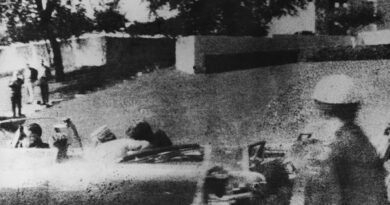Newly Declassified Clues: Lee Harvey Oswald, CIA, and LSD
The Biden administration declassified a new clue last week to the relationship between Lee Harvey Oswald and the Central Intelligence Agency. Among the intersections between Oswald and the CIA, his time as a young Marine at the Atsugi naval air facility in Japan in 1957 is high among them.
Atsugi was a launching pad for U-2 spy flights over the Soviet Union and was also a hub of the CIA’s research into psychedelic drugs. “A CIA memo titled ‘Truth Drugs in Interrogation’ revealed the agency practice of dosing agents who were marked for dangerous overseas missions,” wrote author David Talbot in “The Devil’s Chessboard,” his 2015 biography of former CIA Director Allen Dulles.
Talbot’s exploration of the link ended there: “Some chroniclers of Oswald’s life have suggested that he was one of the young marines on whom the CIA performed its acid tests.”
A new document released in full last week relates directly to Oswald’s time at Atsugi, revealing details about the CIA’s response to testimony from a former agency accountant that the spy service had employed Oswald — who went on to be a gunman in the assassination of President John F. Kennedy in 1963.
The CIA’s role in Kennedy’s assassination remains one of the great unsolved mysteries of American history. A majority of Americans believe the president was killed as part of a conspiracy that went beyond Oswald, and roughly a third believe the CIA or elements within the CIA had a hand in it.
The CIA’s role in Kennedy’s assassination remains one of the great unsolved mysteries of American history.
The main theory posits the assassination as a response to Kennedy’s firing of Dulles, a cloak-and-dagger powerbroker, following the failed CIA Bay of Pigs operation to unseat Fidel Castro’s Communist government in Cuba. Some believers of the theory also point to evidence Kennedy was souring on the Vietnam War or militarism in general. If Dulles did orchestrate a coup against Kennedy, it would be far from his first.
A memorandum from 1978 reports that a finance clerk with the CIA, James Wilcott Jr., had informed a House panel exploring the assassination that “the CIA hired Lee Harvey Oswald when Oswald served in Atsugi.” The memo goes on to cast doubt on Wilcott’s claim, noting that he arrived in Tokyo in 1960, after Oswald had left the base, suggesting that Wilcott’s claim is based on “second hand” information.
A version of the document was declassified by the Trump administration in 2017, though it redacted a portion of a note that runs along the bottom of it. That redaction obscured the name of a CIA official, Dan Nieschur, who fielded requests from congressional investigators in the 1970s and searched Oswald’s files. Jefferson Morley, editor of the Substack newsletter JFK Facts, said that inconsequential lifting of such redactions seems to be common in this latest document release, allowing the government to claim it is releasing thousands of documents, while most had largely already been in the public domain.
The memo, written to a person identified only as “JHW,” explains that CIA official Russ Holmes “inherited the so-called Oswald files, but that he has assured me the Agency had no contact with Oswald.” The memo says that “contrary records” might be in “EA” — a likely reference to the CIA’s East Asia desk — and that they would be searched for and checked if found.” “He is after it,” the memo says of Holmes, who became legendary for his now-declassified CIA archive on the assassination.
The new JFK files include a number of personnel records connected to Wilcott, whose testimony before the House committee in the late 1970s made news at the time.
Oswald’s next few years make much more sense with a connection to the CIA than without them.
After studying Russian while in the military — perhaps trained at the Army Language School in Monterey, California, according to Talbot, sourcing the claim to the Warren Commission chief counsel J. Lee Rankin — Oswald was discharged with a false claim of his mother’s ill health.
Completely broke, with only $203 in his bank account, he took a boat to England nine days after his discharge. Then, according to his wife, Oswald took a military transport flight to Finland, staying at two of the nicest hotels in Helsinki.
Oswald then took an overnight train from Helsinki to Moscow. Once there, he presented himself at the U.S. Embassy to announce he’d become a defector. Embassy staff later recalled that his defection speech sounded odd and rehearsed. He spent two and a half years in the Soviet Union and then, just as curiously as he’d defected, returned home to the United States.
If the series of moves — from the discharge to the flight to the defection to the return — were made at the behest of the CIA, they make sense, with Oswald playing some type of role in the inscrutable world of spycraft. Absent an intelligence link, the tick-tock of Oswald’s post-military years would be situated somewhere between extraordinarily implausible to impossible to pull off.
The CIA is known to have explored creative uses of psychedelics — and Dulles was specifically aware of these activities, even proposing some of the uses. On March 2, 1960, according to a declassified CIA report included in last week’s document release, the CIA director briefed Richard Nixon, then the vice president, on a proposal to deal with Fidel Castro and Cuba. The report, which appears to be another version of a previously declassified document, included plans for economic sabotage of cane production and interference with oil deliveries.
A more innovative idea presented in the briefing, according to the CIA, appears to be a reference to dosing Castro with LSD, which the agency was at the time experimenting with. Nixon was told that the agency had “a drug, which if placed in Castro’s food, would make him behave in such an irrational manner that a public appearance could have very damaging results to him.”
The CIA’s claim to have had no contact with Oswald is undercut by the fact that George de Mohrenschildt, a CIA asset, became close friends with Oswald in the months before the assassination. That spring, de Mohrenschildt traveled to New York, Philadelphia, and Washington. According to documents found in the newly declassified files, at the same time as his trip, the CIA’s Domestic Operations Division ran a search on de Mohrenschildt, “exact reason unknown,” according to two documents created by a CIA analyst included in last week’s declassification.
The covert arm of the division was run at the time by E. Howard Hunt, a black ops specialist who confessed later in life to learning ahead of time of a conspiracy to assassinate Kennedy that involved high-level figures in the CIA.
“It is interesting that Allen’s interest in de Mohrenschildt coincided with the earlier portion of this trip,” the memo concludes, referring to Gale Allen, a case officer with the CIA’s Domestic Operations Division at the time, “and the information would suggest that possibly Allen and de Mohrenschildt were possibly in the same environment in Washington, D.C., circa 26 April 1963.”
In the wake of the latest document release, which also withheld countless additional documents, Fox News host Tucker Carlson reported that a source who reviewed the undisclosed records said they included evidence of CIA involvement in the assassination. Carlson said that he had invited his friend Mike Pompeo, the former CIA director who also withheld crucial documents, on to his show to respond. “Though he rarely turns down a televised interview, he refused to come,” Carlson said. “We hope he will reconsider.”



